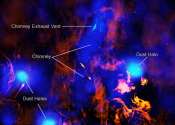Astronomers take a closer look at emission from the supernova remnant MSH 15−56
By analyzing archival data from the Suzaku X-ray satellite, astronomers have learned important information regarding thermal and non-thermal emission from the composite supernova remnant (SNR) designated MSH 15-56. Results ...









